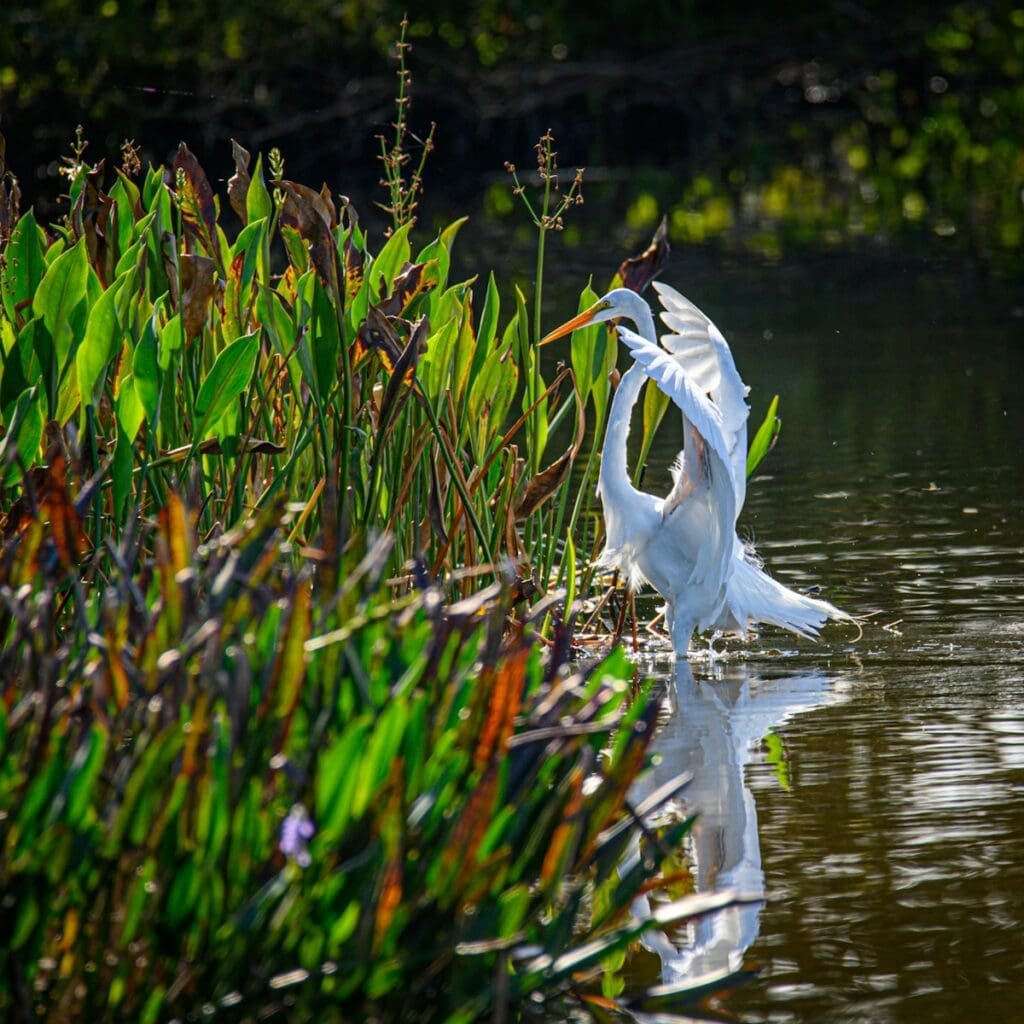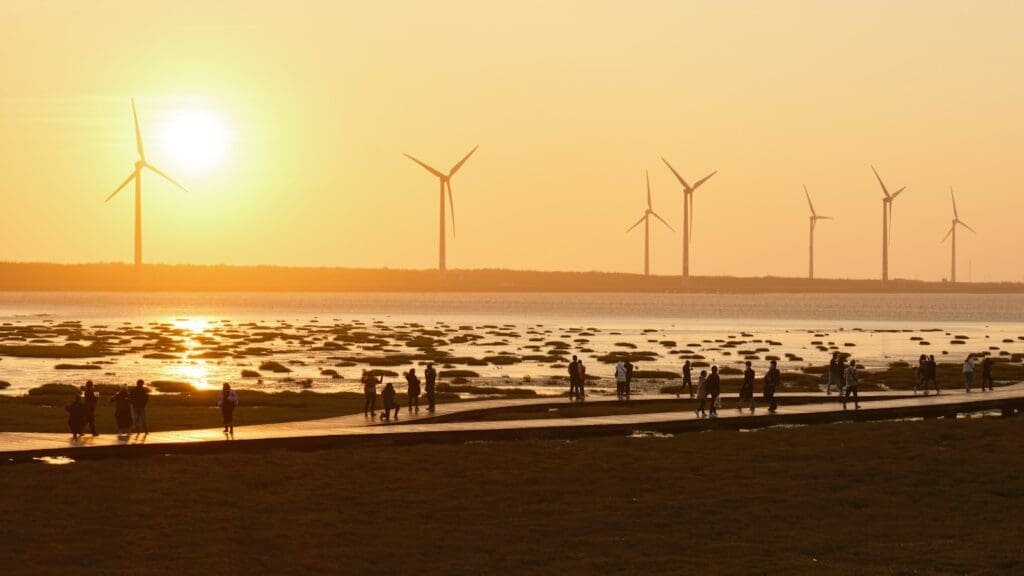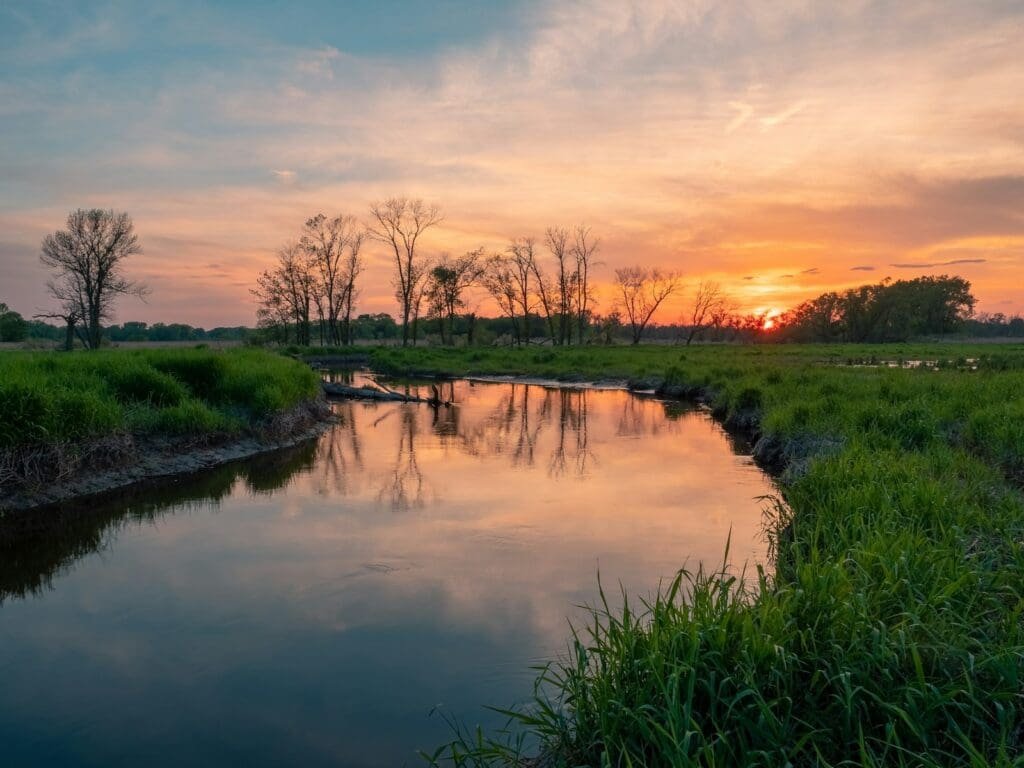Intro To Wetland Restoration
Ever wondered why wetlands are receiving so much attention these days?
Or why there’s a strong emphasis on restoring them?
Stick around as we explore the world of Wetland Restoration Programs. In this article, we’ll discuss what they are, their purpose and key objectives. We’ll also investigate the various types of wetlands and the methods used in restoration programs.
Also, we’ll elaborate on the benefits that these initiatives bring, not just environmentally but also economically and socially. Lastly, we’ll touch on some of the significant case studies to provide you with real-world examples of successful wetland restoration.
So, are you ready to get your feet wet and learn how wetlands are restored, and why it matters to you?
Roll those pant legs up and let’s get started.
Table of Contents
Understanding the Wetland Restoration Program

Definition and Purpose
The wetland restoration program is an initiative aimed at rehabilitating degraded wetlands to their natural conditions. Wetlands include marshes, swamps, bogs, and similar ecosystems, which play a critical role in environmental health.
Key Objectives
The program includes various objectives, such as:
- Improving water quality
- Providing natural habitat for wildlife
- Reducing flood risks
- Enhancing recreational opportunities
Types of Wetlands
Wetlands can be classified into several types:
- Marshes: Dominated by herbaceous plants.
- Swamps: Dominated by woody plants.
- Bogs: Feature acidic waters and peat deposits.
- Fens: Less acidic, fed by groundwater.
Restoration Methods
There are various methods used in the wetland restoration program, including:
- Hydrological Restoration: Reestablishing the natural water flow.
- Vegetation Reconstruction: Planting native plants and removing invasive species.
- Soil Amendments: Enhancing soil health through organic materials.
Hydrological Restoration Techniques
| Technique | Description |
|---|---|
| Rewetting | Restoring wetland hydrology by adding water. |
| Dike Removal | Eliminating man-made barriers. |
| Channel Reconfiguration | Reshaping channels to enhance water flow. |
Benefits of Wetland Restoration
Restoring wetlands has substantial environmental, social, and economic benefits:
- Environmental: Enhances biodiversity, promotes cleaner water, and helps mitigate climate change.
- Social: Provides recreational opportunities and aesthetic benefits.
- Economic: Reduces costs related to flood management and water treatment.
Case Study: An Example of Successful Restoration
One prominent example is the Mississippi River Basin, where restoration efforts have led to significant improvements in water quality and wildlife habitats.
In the context of construction, the wetland restoration program involves specialists from various fields such as hydrology, ecology, and civil engineering. An interdisciplinary approach ensures the successful rehabilitation of these vital ecosystems.
Time Frame for Wetland Restoration

Influence of Size and Condition on Restoration
The time it takes to restore a wetland primarily depends on its size, existing condition, and the specific objectives of the restoration effort. Wetlands that are heavily degraded might require more extensive remediation measures and hence, a longer time for restoration. Conversely, relatively less affected wetlands might bounce back quickly, especially if they are smaller in size.
Species Reintroduction
The process of species reintroduction is also instrumental in wetland restoration. This effort can vary significantly in terms of time. Native plant species might recover quickly within a few growing seasons, but the return of certain animal species might take considerably longer.
Distinct Phases
Generally, a restoration program can be divided into three main phases:
- Initial Restoration: Encompasses the assessment of the wetland state, formulation of the restoration plan, and implementation of the remediation measures. This phase can last a few months to a couple of years.
- Observation Period: The refurbished wetland is monitored regularly to ensure that the restoration is proceeding as planned. Any challenges or unexpected developments can be addressed in this phase, which may extend from 1 to 5 years or more.
- Maintenance Phase: When the wetland has substantially recovered, long-term management and maintenance activities are performed to help the wetland continue to thrive. This period can last indefinitely.
Factors Affecting Wetland Restoration Time
Hydraulic Changes
Changes in the hydraulic (water) environment, such as rewetting or dike removal, can take several years to stabilize fully.
Vegetation Maturation
Vegetation maturation is another time-consuming part of the restoration. The time for plants to reach maturity differs depending on species and surrounding conditions.
Soil Recovery
The soil’s ability to support vegetation can also impact the time frame. The recovery and enhancement of soil health through organic amendments might require an extended period, particularly if existing conditions are highly degraded.
Wildlife Repopulation
Wildlife repopulation, particularly for slower-breeding mammals and birds, can take years to reach a sustainable level within the restored ecosystem.
External Factors
External environmental factors, such as climate, weather patterns, and human impacts, can also influence the overall timeframe. Unfavorable weather sporadic events can slow the process or even necessitate additional restoration measures.
Case Study: Restoration Time Frames
A study featuring detailed analysis of restoration timelines for over 621 wetland projects across Europe estimated that complete functional restoration typically takes between 10-15 years (source: Journal of Applied Ecology). This is, however, a rough estimation and actual restoration time frames can differ significantly based on individual project characteristics and site conditions.
What are the Benefits of Restoring Wetlands?
Enhanced Biodiversity
Restoring wetlands significantly enhances biodiversity by reestablishing habitats for a wide array of plant and animal species. Wetlands serve as breeding grounds for fish, amphibians, birds, and various invertebrates. When these ecosystems are restored, they can support a wider range of wildlife, including some endangered species.
Water Quality Improvement
Wetlands act as natural water filters, removing pollutants from water that flows through them. They help filter out sediments, nutrients, and heavy metals, which improves the quality of both surface and groundwater. This natural filtration process is vital for maintaining clean water sources for human consumption and ecological health.
Flood Mitigation
One of the remarkable benefits of wetland restoration is reduced flood risk. Wetlands act as sponges, absorbing excess rainwater and releasing it slowly, which naturally mitigates flood impacts. This flood control capability protects downstream communities and infrastructure from flood damage and reduces the economic burden of flood management.
Climate Change Mitigation
Wetlands are efficient carbon sinks, trapping carbon dioxide (CO2) and reducing greenhouse gases in the atmosphere. Restored wetlands can sequester carbon through the growth of plant biomass and the formation of organic-rich soils, contributing to climate change mitigation efforts.
Groundwater Recharge
Restored wetlands play a crucial role in groundwater recharge. They help replenish aquifers by allowing water to percolate into the ground, which maintains the balance of local water tables. This process is essential, especially in areas facing water scarcity.
Increased Recreational Opportunities
Wetlands provide numerous recreational opportunities, including bird watching, hiking, fishing, and photography. Restored wetland areas often become popular attractions for both locals and tourists, contributing to community well-being and economic growth through ecotourism.
Improved Soil Health
Restoring wetlands enhances soil health by increasing the organic content and improving soil structure. Healthy soils support diverse plant life and improve the resilience and productivity of the ecosystem. Conservation agriculture and agroforestry practices can benefit from the improved soil conditions in and around restored wetlands.
Ecosystem Services Valuation
The economic valuation of ecosystem services provided by wetlands underscores their importance. These services include water purification, flood control, and biodiversity conservation, all of which can be economically quantified. Cities and municipalities saving costs on water treatment and flood management is a testament to this value.
Educational and Research Opportunities
Restored wetlands serve as living laboratories for education and research. Scientists and students can study ecological processes and conservation techniques, contributing to knowledge advancement and better environmental stewardship.
Case Study: Everglades Restoration
A notable example of wetland restoration is the comprehensive Everglades Restoration Plan in Florida. This massive initiative aims to restore the hydrological conditions and native ecosystems of the Everglades. The success of this project demonstrates the profound environmental, social, and economic benefits of large-scale wetland restoration efforts. More details can be found on the [EPA Website](https://www.epa.gov).
The benefits of restoring wetlands clearly indicate their multifaceted importance, not just for the environment, but for social and economic structures too. With thoughtful planning, wetland restoration can yield long-lasting and wide-ranging positive outcomes.
Disadvantages of Restoring Wetlands

High Costs
One of the significant drawbacks of wetland restoration projects is the financial cost. Restoring wetlands involves extensive planning, specialized equipment, labor, and long-term monitoring. These projects often require substantial investments that might not be immediately available or might divert funds from other pressing environmental or social initiatives.
Uncertain Outcomes
The outcomes of wetland restoration projects can be unpredictable. Despite best efforts, restored wetlands might not reach the desired ecological state or provide expected benefits. Factors such as climatic variations, unforeseen ecological shifts, and challenges in reintroducing native species can impede the success of restoration efforts.
Long Time Frames
The time required for restoring wetlands to a fully functional state can be extensive. Depending on the extent of degradation, a wetland restoration project can take several years or even decades. This long time frame can be a disadvantage, especially when immediate ecological or economic benefits are needed.
Maintenance and Monitoring
Post-restoration, wetlands require ongoing maintenance and monitoring to ensure they remain healthy and functional. This can involve regular inspections, corrective actions, and managing invasive species, all of which require additional resources and long-term commitments.
Potential Displacement of Existing Uses
In some cases, the land targeted for wetland restoration might already be used for agriculture, development, or other human activities. Restoring wetlands can displace these existing uses, causing economic or social disruptions for communities and stakeholders dependent on these lands.
Impact on Local Communities
Wetland restoration projects can impact local communities in various ways. This can include changing land use patterns, altering local hydrology, or affecting local wildlife populations. Such changes may lead to conflicts or resistance from local residents, complicating restoration efforts.
Legal and Administrative Challenges
Negotiating the legal and regulatory landscape is another challenge in wetland restoration. Projects often require multiple permits and compliance with numerous environmental regulations. This bureaucratic process can slow down project timelines and increase costs.
Case Study: Wetlands Restoration Challenges
The Kissimmee River Restoration
A notable example is the restoration of the Kissimmee River in Florida. While the project has achieved significant ecological benefits, it faced several challenges:
- High Costs: The project has required substantial financial investments, with costs running into hundreds of millions of dollars.
- Extended Time Frames: The restoration has spanned over several decades and is still ongoing.
- Uncertain Initial Outcomes: Early phases experienced setbacks, requiring adaptive management strategies to correct issues as they emerged.
Despite these challenges, the project demonstrates that overcoming the disadvantages of wetland restoration is possible with proper planning, continuous monitoring, and community engagement. More information can be found on the Southwest Florida Water Management District website.
Wrapping Up on Wetland Restoration
Wetland Restoration, an initiative aimed at rehabilitating degraded wetland environments to their natural state is increasingly gaining global recognition.
The efforts focus on enhancing water quality, strengthening natural wildlife habitats, reducing flood risks, and providing a haven for recreation.
Different wetlands including marshes, swamps, bogs, and fens all form an essential part of the rich ecological tapestry to be preserved. Various restoration methods such as Hydrological Restoration, Vegetation Reconstruction, and Soil Amendments are used depending on the site and specifics of degradation.
Though the timeline for wetland restoration may vary, the efforts towards restoring these natural wonders are well worth it. They provide substantial environmental, economic, and social benefits, notably improving water quality, enhancing biodiversity, and offering flood mitigation amongst many others.
However, it’s also important to note that these restoration projects come with challenges of their own including high costs, long-time frames, and unpredictable outcomes.
Frequently Asked Questions – FAQs
What are the main objectives of wetland restoration?
The primary goals are enhancing water quality, strengthening the natural habitat for wildlife, reducing flood risks, and promoting recreational opportunities.
What types of wetlands are there?
Wetlands include marshes, swamps, bogs, and fens. Their classification is based on the dominant flora and specific ecological conditions.
What are the methods used in wetland restoration?
Methods range from Hydrological Restoration, which involves reestablishing natural water flow, to Vegetation Reconstruction through planting native plants, and Soil Amendments aimed at enhancing soil health.
How long does it generally take to restore a wetland?
The timeline can vary greatly depending on the size and state of the wetland, but typical estimation ranges from 10-15 years.
What are the benefits of restoring wetlands?
The benefits are multifold, including environmental aspects like enhanced biodiversity, cleaner water, and flood mitigation and social benefits such as increased recreational opportunities and aesthetic enhancements.
What are the possible drawbacks of wetland restoration?
Challenges might include high costs, uncertain outcomes, time-consuming processes, and potential displacement of existing land uses.






